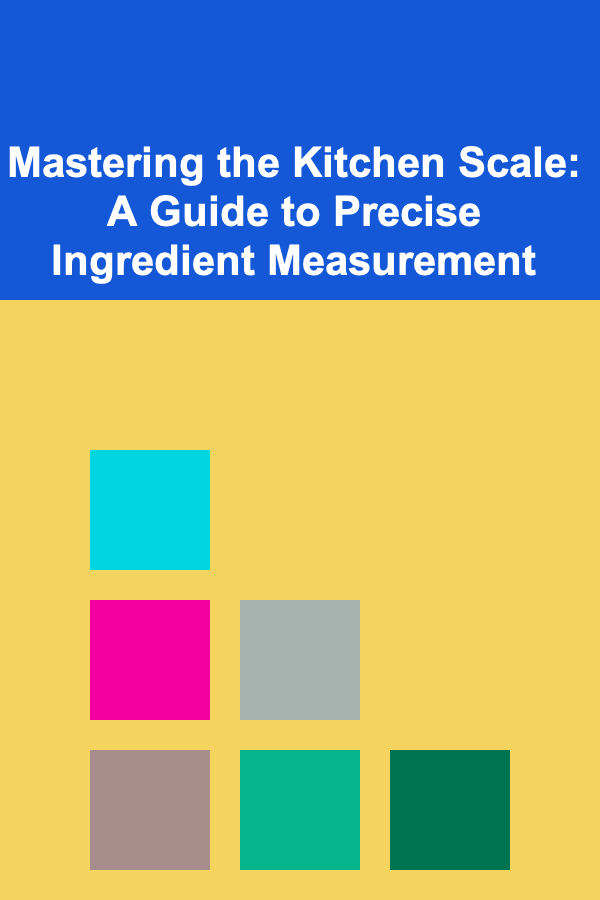
Mastering the Kitchen Scale: A Guide to Precise Ingredient Measurement
ebook include PDF & Audio bundle (Micro Guide)
$12.99$11.99
Limited Time Offer! Order within the next:

In the culinary world, accuracy is paramount. While experienced cooks might sometimes rely on intuition and a pinch of this or a dash of that, consistent and repeatable results, especially in baking and precise cooking techniques, demand precision. That's where the humble kitchen scale comes in. It's an indispensable tool for anyone serious about improving their cooking and baking outcomes, providing a level of accuracy that volume measurements simply can't match. This comprehensive guide will explore the benefits of using a kitchen scale, different types available, how to use them effectively, and advanced techniques for maximizing their potential.
Why Weigh? The Advantages of Using a Kitchen Scale
Transitioning from volume to weight measurements offers a multitude of advantages:
1. Unmatched Accuracy: The Foundation of Consistency
The primary benefit of using a kitchen scale lies in its superior accuracy. Volume measurements, like cups and spoons, are inherently imprecise. Factors like how tightly an ingredient is packed, the size of the measuring cup, and even humidity can significantly impact the actual amount being used. A cup of flour, for example, can vary in weight by as much as 20-30% depending on how it's scooped. This variation can dramatically affect the final product, especially in baking, where precise ratios are crucial for proper texture and rise. By weighing ingredients, you eliminate these variables and ensure consistent results every time.
2. Streamlined Efficiency: Less Cleaning, More Cooking
Using a kitchen scale simplifies the measuring process. Instead of dirtying multiple measuring cups and spoons, you can often measure all the ingredients directly into the same bowl, resetting the scale to zero (taring) between each addition. This minimizes cleanup and saves valuable time, especially when preparing complex recipes with numerous components.
3. Recipe Conversions: Seamlessly Adapting to Different Units
Kitchen scales are invaluable for converting recipes from volume to weight, or from one unit of weight to another (e.g., grams to ounces). Many international recipes, particularly those from Europe, use metric measurements (grams and milliliters) extensively. A kitchen scale allows you to easily adapt these recipes without relying on unreliable conversion charts or online calculators. It also empowers you to experiment with existing recipes, adjusting ingredient ratios to suit your preferences and create your own unique culinary masterpieces.
4. Portion Control: Managing Your Diet with Precision
Beyond baking and cooking, kitchen scales are excellent tools for portion control. Whether you're tracking macronutrients for weight loss, managing dietary restrictions, or simply trying to maintain a healthy eating plan, a scale allows you to precisely measure serving sizes and calorie counts. This level of control is far more accurate than estimating portions by eye, which can often lead to overconsumption.
5. Ingredient Cost Management: Minimizing Waste, Maximizing Value
In commercial kitchens, and even for home cooks on a budget, kitchen scales can help optimize ingredient usage and minimize waste. By accurately measuring ingredients, you can avoid using too much or too little, reducing the likelihood of recipe failures or ingredient spoilage. Over time, this can lead to significant cost savings, especially for expensive ingredients like spices, nuts, and extracts.
Choosing the Right Kitchen Scale: A Buyer's Guide
The market offers a diverse range of kitchen scales, each with its own set of features and price points. Understanding the different types and their functionalities is crucial for selecting the scale that best suits your needs.
1. Digital Scales: The Modern Standard
Digital kitchen scales are the most popular type, offering a combination of accuracy, convenience, and affordability. They typically feature a digital display that shows the weight in various units (grams, ounces, pounds, etc.), a tare function, and sometimes additional features like a timer or temperature sensor. Digital scales are generally more accurate than mechanical scales, especially at lower weights.
Key Features to Consider:
- Accuracy: Look for a scale with a resolution of at least 1 gram or 0.1 ounce. For very small amounts of ingredients (e.g., spices), a scale with a higher resolution (0.1 gram or 0.01 ounce) might be necessary.
- Capacity: Choose a scale with a capacity that matches your typical cooking and baking needs. Most kitchen scales have a capacity of 5-10 kilograms (11-22 pounds), which is sufficient for most home cooks.
- Tare Function: The tare function is essential for zeroing out the weight of the container and measuring ingredients directly into it. Ensure the scale has a reliable tare function that works quickly and accurately.
- Units of Measurement: A good kitchen scale should be able to display weight in multiple units, including grams, ounces, pounds, and sometimes milliliters (for liquids).
- Display: Opt for a scale with a clear and easy-to-read display, preferably with a backlight for improved visibility.
- Power Source: Consider the power source of the scale. Some scales run on batteries, while others are rechargeable. Battery-powered scales are generally more convenient, but rechargeable scales can save money in the long run.
- Durability: Choose a scale made from durable materials that can withstand regular use and cleaning. Stainless steel is a popular choice for its durability and ease of cleaning.
2. Mechanical Scales: A Classic Option
Mechanical kitchen scales use a spring mechanism to measure weight. They are generally less accurate than digital scales and can be more difficult to read, especially at lower weights. However, they do not require batteries and are often more durable. Mechanical scales are a good option for those who prefer a traditional aesthetic or for situations where access to electricity or batteries is limited.
Considerations:
- Accuracy: Mechanical scales are generally less accurate than digital scales, especially at lower weights. This is because the spring mechanism can wear down over time and lose its accuracy.
- Readability: The dial on a mechanical scale can be difficult to read, especially for those with poor eyesight.
- Maintenance: Mechanical scales require more maintenance than digital scales. The spring mechanism may need to be adjusted or replaced periodically.
3. Specialty Scales: Catering to Specific Needs
In addition to digital and mechanical scales, there are also specialty scales designed for specific purposes. These include:
- Coffee Scales: These scales are designed for precisely measuring coffee beans and water for brewing. They often feature a built-in timer and a high level of accuracy (0.1 gram resolution).
- Jewelry Scales: These scales are designed for measuring very small amounts of precious metals and gemstones. They have an extremely high level of accuracy (0.01 gram or even 0.001 gram resolution).
- Pocket Scales: These small, portable scales are ideal for weighing ingredients on the go. They are often used by travelers, campers, and those who need to weigh items in a variety of locations.
Mastering the Basics: Using a Kitchen Scale Effectively
Using a kitchen scale is relatively straightforward, but understanding a few key principles will ensure accuracy and efficiency.
1. Level Surface: The Foundation of Accurate Measurement
Always place your kitchen scale on a flat, level surface. An uneven surface can cause the scale to register inaccurate readings. Avoid placing the scale on carpets, countertops with grooves, or any surface that is not perfectly horizontal.
2. Choosing the Right Units: Grams, Ounces, and More
Select the appropriate units of measurement for your recipe. Most recipes use grams (g) or ounces (oz). If you're using a recipe that calls for a different unit, such as pounds (lbs) or kilograms (kg), make sure to convert it to the units your scale displays. Digital scales typically have a button or switch that allows you to toggle between different units.
3. The Tare Function: Your Zeroing Power
The tare function is your best friend when using a kitchen scale. It allows you to zero out the weight of the container you're using to measure ingredients, ensuring that you're only measuring the weight of the ingredient itself. To use the tare function, place the empty container on the scale and press the "Tare" button. The display should reset to zero. You can then add the ingredient to the container and the scale will display the weight of the ingredient only.
4. Gradual Addition: Avoiding Overestimation
When adding ingredients to the scale, add them gradually. This allows you to stop when you reach the desired weight and avoid overshooting. If you accidentally add too much of an ingredient, remove the excess until you reach the correct weight.
5. Weighing Liquids: Account for Density
When weighing liquids, remember that volume and weight are not always directly proportional. The density of a liquid affects its weight per unit volume. For example, one cup of water weighs approximately 236 grams, while one cup of oil weighs approximately 218 grams. Most recipes specify the weight of liquids in grams or ounces, so it's important to use a scale to measure them accurately. Some scales have a liquid measurement mode (often indicated by 'ml' for milliliters) which assumes the density of water. This is generally accurate for water-based liquids, but for oils or other liquids with different densities, weighing by grams is more accurate.
6. Handling Sticky Ingredients: Minimizing Mess
Weighing sticky ingredients like honey, syrup, or peanut butter can be messy. To minimize the mess, try these tips:
- Spray the container with cooking spray: This will help prevent the ingredient from sticking to the sides of the container.
- Use parchment paper: Line the container with a piece of parchment paper. This will make it easier to remove the ingredient and clean the container.
- Weigh directly into the mixing bowl: If possible, weigh the ingredient directly into the mixing bowl to avoid transferring it.
Advanced Techniques: Maximizing Your Kitchen Scale's Potential
Once you've mastered the basics, you can explore some advanced techniques to further enhance your cooking and baking skills.
1. Baking Percentages: Unlock Consistent Baking Results
Baking percentages are a system of expressing ingredient ratios as a percentage of the total flour weight. This technique provides a standardized and consistent way to scale recipes up or down and to adjust ingredient ratios to achieve specific textures and flavors. To use baking percentages, you first need to determine the total weight of the flour in the recipe. Then, calculate the percentage of each ingredient relative to the flour weight. For example, if a recipe calls for 500 grams of flour and 300 grams of water, the water percentage would be 60% (300/500 * 100). Using baking percentages allows you to modify recipes while maintaining the crucial relationships between ingredients, leading to predictable and repeatable results.
2. Calibrating Your Scale: Maintaining Accuracy Over Time
Over time, kitchen scales can lose their accuracy due to wear and tear. It's important to calibrate your scale periodically to ensure that it's providing accurate readings. Most digital scales have a calibration function that allows you to recalibrate them using a known weight. Refer to your scale's instruction manual for specific calibration instructions. If your scale does not have a calibration function, you can test its accuracy by weighing a known weight, such as a bag of sugar or a calibration weight set. If the scale is not accurate, you may need to replace it.
3. Creating Custom Recipes: Experimenting with Confidence
Once you understand the principles of weighing ingredients, you can start creating your own custom recipes. Use your kitchen scale to experiment with different ingredient ratios and develop your own unique flavor combinations. By carefully measuring ingredients and recording your results, you can refine your recipes over time and create dishes that are perfectly tailored to your taste.
4. Scaling Recipes Up or Down: Adapting to Different Needs
Kitchen scales make it easy to scale recipes up or down to accommodate different serving sizes. To scale a recipe, simply multiply the weight of each ingredient by a scaling factor. For example, if you want to double a recipe, multiply the weight of each ingredient by 2. If you want to halve a recipe, multiply the weight of each ingredient by 0.5. When scaling recipes, it's important to consider the impact on cooking times and temperatures. You may need to adjust these factors depending on the size of the dish.
5. Sous Vide Precision: Achieving Perfect Doneness
Sous vide cooking involves cooking food in a water bath at a precise temperature. Kitchen scales are essential for accurately measuring ingredients for sous vide recipes, especially when making sauces, marinades, and brines. By precisely measuring the ingredients, you can ensure that the food is cooked to the desired level of doneness and that the flavors are balanced.
Troubleshooting Common Issues
Even with the best intentions, you might encounter some challenges when using a kitchen scale. Here are some common issues and how to address them:
- Scale not turning on: Check the batteries or power cord. Replace the batteries or ensure the power cord is securely plugged in.
- Inaccurate readings: Ensure the scale is on a level surface. Recalibrate the scale if necessary.
- Display flashing or showing error messages: Consult the scale's instruction manual for troubleshooting tips. It may indicate an overload or other issue.
- Scale not taring: Make sure nothing is touching the scale platform while taring. Clean the platform and try again.
Cleaning and Maintenance: Extending the Life of Your Scale
Proper cleaning and maintenance will help extend the life of your kitchen scale and ensure that it continues to provide accurate readings. Here are some tips:
- Clean the scale regularly: Wipe the scale with a damp cloth after each use to remove any food residue. Avoid using harsh chemicals or abrasive cleaners, as these can damage the scale's surface.
- Protect the scale from moisture: Avoid exposing the scale to excessive moisture, as this can damage the electronic components. If the scale gets wet, dry it thoroughly before using it again.
- Store the scale in a safe place: Store the scale in a safe place where it won't be damaged or knocked over.
- Replace batteries as needed: Replace the batteries when they are low to ensure that the scale continues to function properly.
Conclusion: Elevating Your Culinary Skills with Precision
Investing in a kitchen scale is an investment in your culinary skills. By embracing the precision of weight measurements, you can unlock a new level of consistency, efficiency, and creativity in your cooking and baking. From achieving perfect textures in baked goods to scaling recipes with ease and managing your diet with precision, the kitchen scale is an indispensable tool for any serious home cook or professional chef. So, embrace the power of weighing, experiment with new techniques, and elevate your culinary journey to new heights!

Cost Accountant Handbook: Techniques for Accurate Costing and Budgeting
Read More
How to Answer Stress Interview Questions
Read More
How to Start a Side Hustle and Manage Finances Effectively
Read More
Unlocking Success as an IT Support Specialist: A Comprehensive Guide to IT Service Management
Read More
How to Understand Quantum Computing for Financial Modeling
Read More
10 Tips for Promoting Your Sculptural Installation to the Public
Read MoreOther Products

Cost Accountant Handbook: Techniques for Accurate Costing and Budgeting
Read More
How to Answer Stress Interview Questions
Read More
How to Start a Side Hustle and Manage Finances Effectively
Read More
Unlocking Success as an IT Support Specialist: A Comprehensive Guide to IT Service Management
Read More
How to Understand Quantum Computing for Financial Modeling
Read More